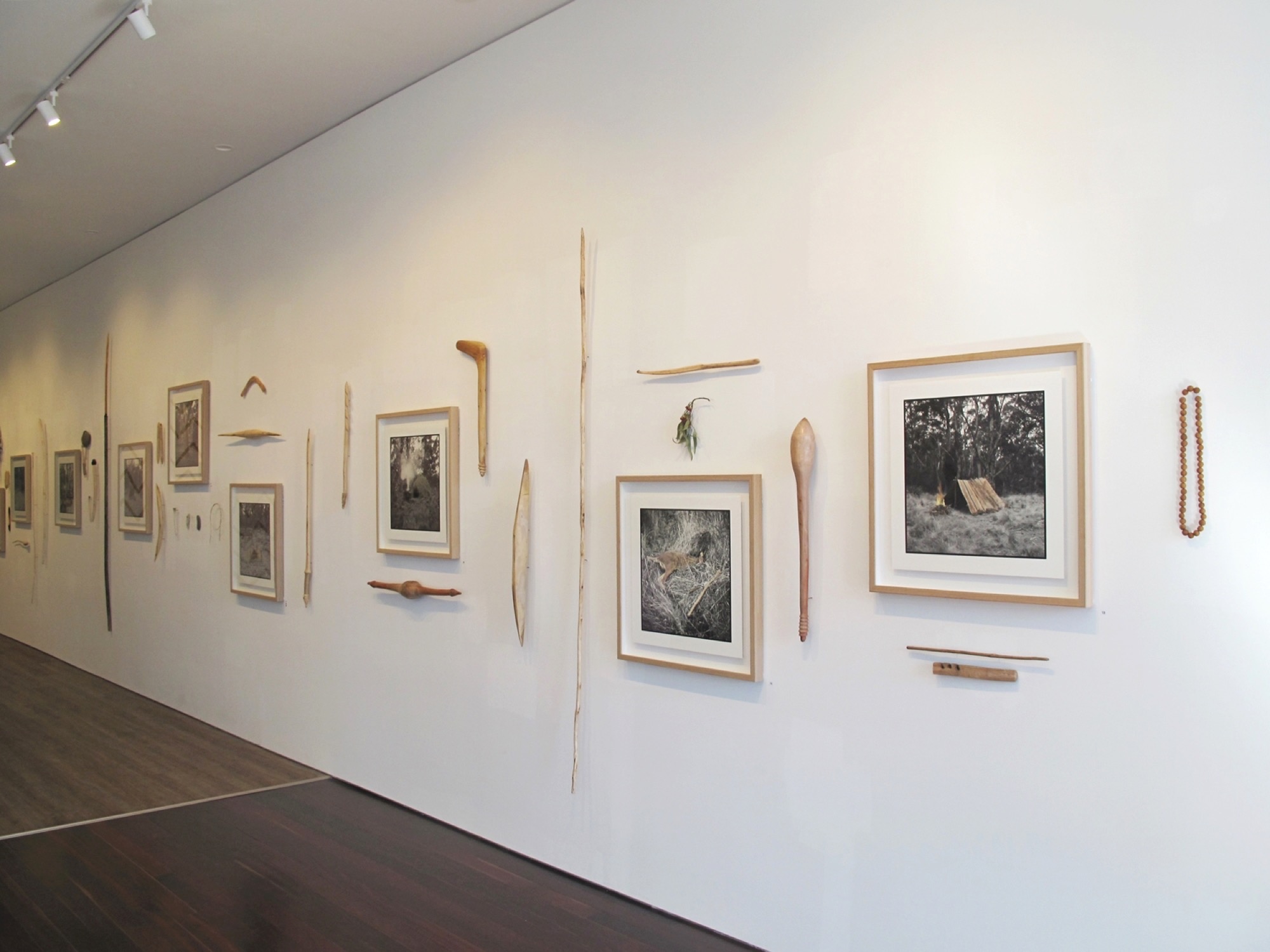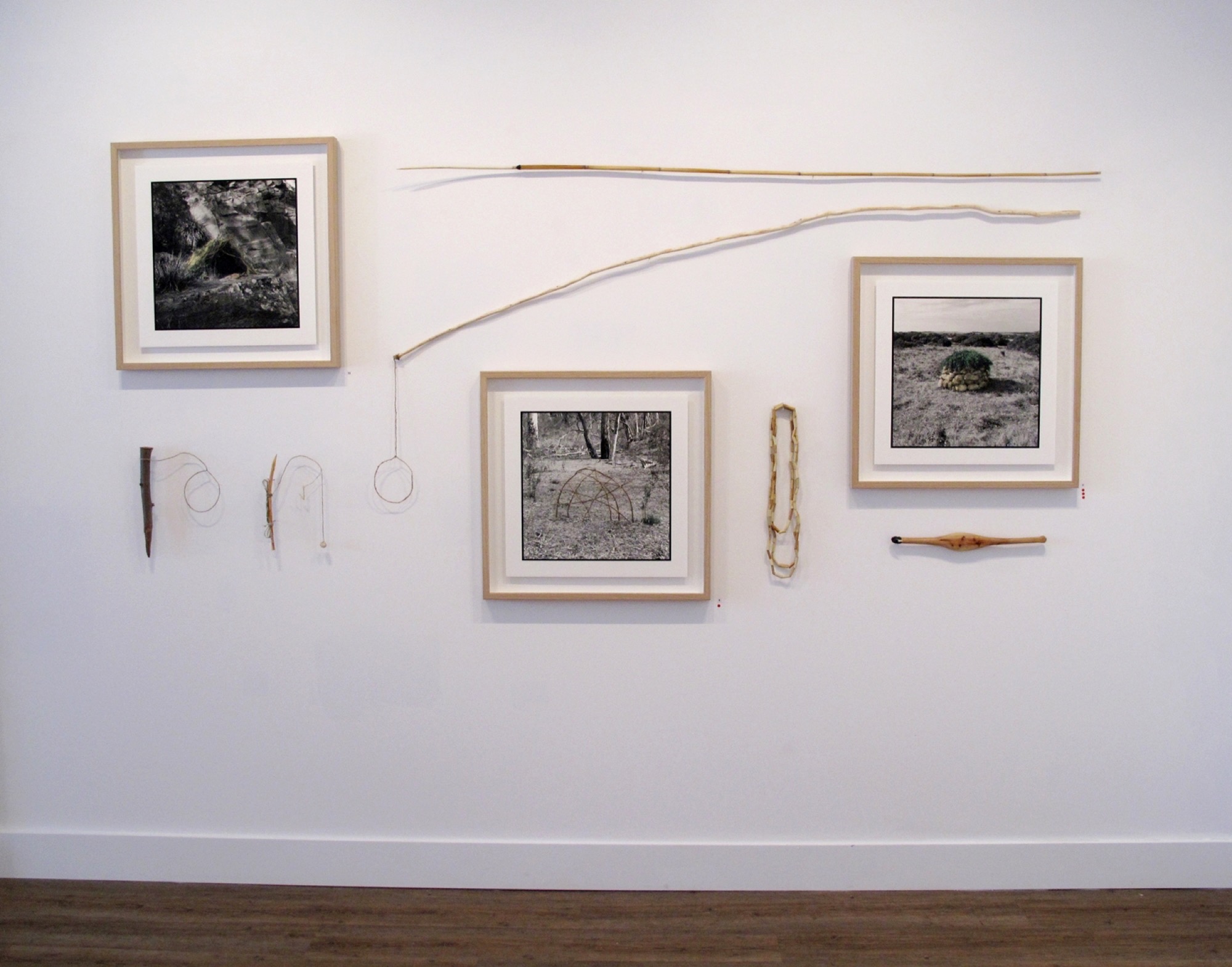James Tylor: un-resettling
Helen Hughes
In recent years, Bruce Pascoe's widely read Dark Emu: Black Seeds: Agriculture or Accident? (2014) and Bill Gammage's The Biggest Estate on Earth: How Aborigines Made Australia (2011) have helped cultivate a more general understanding of the history of Aboriginal land management, agricultural practices, and general custodianship of the lands and waterways of this continent. Their scholarship has thoroughly obliterated many of the 'facts' underpinning racist 'theories' that accompanied colonisation, such as the notion that Aboriginal people lived day-by-day, hunting, fishing and harvesting without the technology to store and preserve foods, or that there were no architectural impositions upon the to land to be seen. On the contrary, Pascoe and Gammage meticulously compile information derived from cultural memory, they examine extant sites, and trawl through early colonial diaries and journals to demonstrate just how complex and sophisticated Aboriginal land management systems were at the moment of colonisation, and how, without continuous Aboriginal land management (notably without controlled burnings), the Australian bush has become the dangerous tinderbox we know it to be today. Indeed, in many instances throughout his book, Pascoe suggests how commercial farmers in Australia today might learn from the many-thousand-year-old Aboriginal land management technologies to increase productivity and decrease the deleterious environmental effects that come as the result of growing wheat and farming hard-footed animals such as cows, sheep and pigs.

Pascoe and Gammage's literary exercises have a parallel in art history. In recent decades, both Jeannette Hoorn and Worimi historian John Maynard have shown us how the convicted forger-cum-colonial artist Joseph Lycett exposed—even if only inadvertently—'the lie of terra nullius' through his paintings of the New South Wales region, which clearly depicted Awakbal occupation and custodianship of the land before colonial governance began to commission Aboriginal occupants out of the picture frame. (N.B. The defiant cover image of Gammage's book is a c. 1817 Lycett watercolour illustrating the use of controlled fire as a technique for hunting kangaroo.)

This is the rich and vital intellectual, cultural and historiographic context in which the practice of Tarndanyangga Adelaide–based artist James Tylor operates. For his most recent exhibition titled un-resettling at Vivien Anderson Gallery, Tylor—of Nunga, Māori and European ancestry—has created traditional Indigenous architectures, stencil paintings on rocks, tidal fishtraps, fireplaces, scar trees and land-marking poles on country, and has photographed them in black and white, later hand-colouring the prints and framing them for exhibition. In addition, the artist has hand-crafted forty traditional objects specific to the Kaurna and Ngarrindjeri language groups, including wiri (clubs), clapsticks, kaya (spears), kuya piri niri (fishing lines and hooks), yoko (hand-held wooden vessels for carrying infants and food items), as well as grinding stones, necklaces and stone tools.

The photographs and hand-crafted objects are installed in busy clusters along the gallery walls, interfering with each other's lines of sight, and in several places are laid over hand-painted zigzagging designs representative of water and the meander of a river in a red ochre colour and a shimmering gold paint. The yoko is displayed on a mirrored plinth, offering viewers optics of its finely crafted underside, and the grindstone on a sheet of black Perspex, which offsets the pale sprigs of spin-head mat-rush (Lomandra longifolia), a seed that can be ground down to make a bread flour. Further, in several places throughout the installation, a branch of pink flowering gum here and a colourful feather there are pinned to the wall. These naturally occurring objects help convey, and create, a sense of place—of connection back to country.

Tylor's self-directed process as an artist is one of learning and continuing or, in many cases, reviving traditional cultural practices that have waned or disappeared since European colonisation. For instance, he learnt how to make Barkindji huts, spears, clubs and stone tools when he was a child in Menindee in far west New South Wales. More recently, he learnt weaving from Ngarrindjeri master weaver Yvonne Koolmatrie. In this regard, Tylor's work bears much in common with that of Mutti Mutti/Yorta Yorta and Boon Wurrung/Wemba Wemba artist and curator Maree Clarke (also represented by Vivien Anderson Gallery), whose practice pivots as well around the revival and celebration of cultural traditions from south eastern Aboriginal Australia. In some cases, Clarke's process of cultural revival is based on interactions with museum artefacts—such as her kangaroo tooth necklaces, kopi (gypsum mourning caps), and work on possum skin cloaks. For instance, she embarked on her 75-tooth Thung-ung coorang (Kangaroo tooth necklace) (2013) after viewing historical nineteenth-century examples of kangaroo teeth necklaces in the collection of Museum Victoria, and in so doing revived a cultural tradition that had not been practiced in this part of the country for over a century. For un-resettling, Tylor too worked with several Kaurna objects from the Museum of South Australia's Australian Aboriginal Cultures collection—supplementing knowledge of the object in hand by researching historical texts and artworks such as George French Agnas's watercolours and the naturalist William Blandowski's prints to extract further contextual information. In the artist's words, 'I used whatever information I could without breaking with protocols to relearn traditional culture that my family had lost due to colonisation.'

For Tylor, this gesture of revival is conceived as a reparative to the official assimilationist policies that Aboriginal people were subjected to from the moment of colonisation until at least the early 1970s, and which attempted systematically to strip First Nations peoples of land, language and culture. It also has the potential, as Pascoe and Gammage demonstrate in their popular books, to prompt the public to listen more carefully to Indigenous knowledges as we face the uncertain and highly volatile environment of the future—replete with auguries of climate change and the threat of food and water shortages. The embrace of Indigenous traditional knowledges as we grapple with these concerns is explored more speculatively in the cli-fi writings of self-described Indigenous futurist, Wiradjuri woman Hannah Donnelly, whose stories imagine environmental apocalypse and ingenious Indigenous responses to it. In a recent panel at the Australian Centre for Contemporary Art, Donnelly—echoing the lyrics of Afro-futurist Sun Ra from the last century—made the astute point that the future, at least, has not been colonised, and for this reason is a potent and productive intellectual space in which to reside. For all the gestures that Tylor's works make to the past (signalled by his use of outdated photographic media: hand-coloured black and white prints in this exhibition, and nineteenth-century style Becquerel Daguerreotypes in other recent bodies of work), it seems also to train its focus on this future space. The exhibition's title, un-resettling, may suggest something of this complex temporality too: the huts and lean-tos may be conceived not as a repetition or reproduction of a past practice, but rather a continuation that extends both backwards and forwards in time.
Helen Hughes is research curator at Monash University Museum of Art, and an assistant lecturer in Art History and Curatorial Practice in the Faculty of Art, Design & Architecture at Monash University.
Title image: James Tylor, un-resettling, 2017, installation view. Courtesy the artist and Vivien Anderson Gallery)


